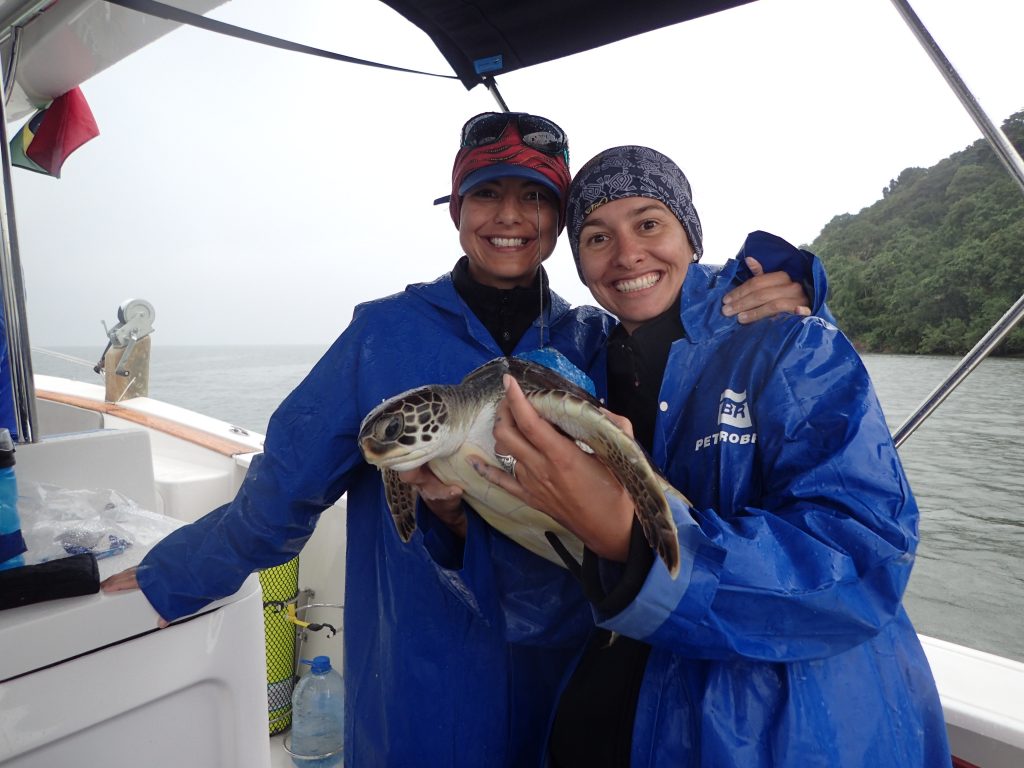This research topic recognizes that an understanding of how species use space is fundamental for their conservation. Thus, the Marine Turtle Research, Ecology and Conservation Group uses a variety of approaches (e.g., photo ID, satellite telemetry, animal borne-cameras, oceanographic dispersal models, aerial surveys) to determine the spatial ecology of marine turtles, and to explore how environmental parameters influence their spatial distribution. We use information on the spatial and temporal distribution of marine turtles to identify key habitats, critical resources, and discrete aggregation areas to inform their management.
SPATIAL ECOLOGY OF MARINE TURTLES
SPECIFIC PROJECTS
Understanding the temporal distribution of juvenile green turtles in south Brazil to inform their conservation
Spatial distribution of juvenile green turtles in Bimini to inform the design of marine protected areas
Population structure of marine turtles in Crystal River
Distribution and mating dynamics of male turtles in Brazil
Spatial ecology of Hawksbill turtles in Brazil
PUBLICATIONS
**Hardin E. E., Cullen J. A. Fuentes, M. M. P. B. (2024). Comparing acoustic and satellite telemetry: an analysis quantifying the space use of Chelonia mydas in Bimini, Bahamas. R. Soc. Open Sci. 11:231152. 231152.
Santos, A., Cullen, J., Vieira, D.H.G., Lima, E.H., Quennessen, V., Santos, E.A.P.D., Bellini, C., Ramos, R. Fuentes, M. M. P. B. . (2023) Decoding the internesting movements of marine turtles using a finescale behavioral state approach. Frontiers in Ecology and Evolution, 11, p.1229144
Kot. C.Y. e.t al., Fuentes, M. M. P. B. ., Halpin, P.N. (2022). Network analysis of sea turtle movements and connectivity: a tool for conservation prioritization. Diversity and Distribution. 00, 1– 20
**Hardin, E.E., Fuentes, M. M. P. B. (2021). A systematic review of acoustic telemetry as a tool to gain insights into marine turtles ecology and aid their conservation. Frontiers in Marine Science. 8(1649).
**Santos, A. J. B., Bellini, C., Santos, E. A. P., Sales, G., Ramos, R., Vieira, D. H. G., . . . Fuentes, M. M. P. B. (2021). Effectiveness and design of marine protected areas for migratory species of conservation concern: A case study of post-nesting hawksbill turtles in Brazil. Biological Conservation, 261, 109229.
** Gillis, A.J., Wildermann, N.E., Ceriani, S.A., Seminoff, J.A., Fuentes, M.M.P.B. (2020) Evaluating different spatial scales of forage item availability to determine diet selection of juvenile green turtles (Chelonia mydas). Marine Biology 167, 170.
Fuentes, M. M. P. B., Wildermann, N., Gandra, T.B.R., Domit, C. (2020). Cumulative threats to juvenile green turtles in the coastal waters of southern and southeastern Brazil. Biodiversity and Conservation 29,1783-1803.
#Wildermann, N.E., Sasso, C.R., Stokes, L.W., Snodgrass, D., Fuentes, M. M. P. B. (2019). Habitat use and behavior of multiple species of marine turtles at a foraging area in the Northeastern Gulf of Mexico. Frontiers in Marine Science. 6, 155.
Fuentes, M. M. P. B., Gillis, A.J., Ceriani, S.A., Guttridge, T. L., Van Zinnicq Bergmann, M.P.M., Smukall, M. Gruber, S.H., Wildermann, N. (2019). Delineating Marine Protected Areas in Bimini, Bahamas by considering hotspots for the green turtle (Chelonia mydas). Biodiversity and Conservation, 28,197–211.
#Wildermann, N. Sasso, C., Gredzens, C., Fuentes, M. M. P. B. (2018). Assessing the effect of recreational scallop harvest on the distribution and behavior of foraging marine turtles. Oryx, 1-8
**Wildermann, N., Critchell, K., Fuentes, M. M. P. B., Limpus, C., Wolanski, E., Hamann, M. (2017) Does behavior affect the dispersal of flatback post-hatchlings in the Great Barrier Reef? Royal Society Open Science 4 (5), 170164.
**Williams J, Pierce, S J., Rohner, C. A., Fuentes, M. M. P. B., Hamann, M. (2017). Spatial distribution and residency of green and loggerhead sea turtles using coastal reef habitats in southern Mozambique . Frontiers in Marine Science. 3:288.
Fuentes, M. M. P. B., Bell I., Hagihara R., Hamann M., Hazel J., Huth A., Seminoff J., Sobtzick S., Marsh H. (2015). Improving in-water estimates of marine turtle abundance by adjusting aerial survey counts for perception and availability biases. Journal of Experimental Marine Biology and Ecology, 471, 77-83.
COLLABORATORS
Armando Santos
Camila Domit, Laboratory of Ecology and Conservation at the Federal University of Paraná
Fundação Pró-Tamar
Chris Sasso, NOAA’s Southeast Fisheries Science Center
Tim Jones, Florida Department of Environmental Protection
Camila Domit, Laboratory of Ecology and Conservation at the Federal University of Paraná
Fundação Pró-Tamar
Chris Sasso, NOAA’s Southeast Fisheries Science Center
Tim Jones, Florida Department of Environmental Protection
FUNDING
National Science Foundation
Sea turtle License Plate
Waterlust
The National Academies of Science, Engineering, and Medicine Gulf Research Program
National Geographic Foundation
Sea turtle License Plate
Waterlust
The National Academies of Science, Engineering, and Medicine Gulf Research Program
National Geographic Foundation







